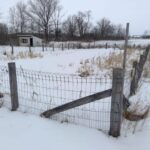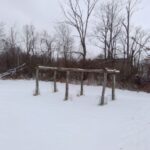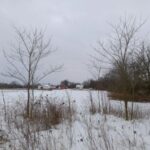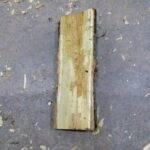By Gabe Ross, Farm Manager

All types of wood and trees have different strengths and weaknesses. Depending on what you are using the wood or planting the tree for, you will want to choose the right tree. One of my favorite trees that has many uses and is often overlooked or even frowned upon as a scrubby or “trash” tree is the black locust (Robinia pseudoacacia). The native range of the black locust is in the Eastern United States, but the exact limits are disputed and unknown because it was moved and planted in other places starting at a very early date. This tree was so useful that it was one of the early trees introduced to Europe from North America as early as the 1600’s. This fast-growing tree is often found in fence rows and in forest edges due to its shade intolerance. It can be seen all over Delaware County.
Not to be confused with the honey locust (Gleditsia triacanthos) which has a lot of very large thorns and long seed pods, black locust has very small and fewer thorns with short seed pods. Both trees are in the Fabaceae or pea family. Being from the pea family, one of the black locust’s first positive attributes is its ability to fix atmospheric nitrogen into the soil, just like clover, alfalfa, and soybeans. While the tree is relatively short-lived (less than 100 years typically) and doesn’t get huge (40-60 ft.), it grows very quickly and can be planted when converting grassland into woodland to provide shade and habitat. While the bigger trees that grow more slowly are establish themselves, the faster growing locust is also useful for erosion control and establishing shade for livestock. The beautiful white and fragrant flowers of black locust are a favorite of bees. Because of its good attributes and uses, it is a tree that is often used in hedgerows, silvopasture and agroforestry endeavors.

The black locust is useful as a live tree and for its lumber. Black locust is one of the most rot resistant and strongest woods available. In my experience it outlasts pressure treated pine in most cases. This makes it a favorite for fence posts and historically it was used in the sills of houses, pegs for timber frame buildings and any other outdoor or ground contact uses. I have made raised beds out of black locust that lasted much longer than cedar. I have two black locust posts on my farm that my great grandfather put in, that are still in use today. Black locust is also very strong like hickory, and good for things like axe and hammer handles. Black locust has a unique yellowish green color when cut that mellows when dry. The wood is also very stable with swings in humidity. Around the turn of the 20th century many streets were paved with wood bricks instead of masonry bricks. These streets were easier on horses’ feet and wagon wheels, while also being much quieter. One of the preferred woods for these streets was black locust. One such alley in Chicago lasted over 100 years and was recently replaced with new black locust pavers. Black locust also makes long lasting and hot burning firewood.


While the black locust is viewed by some as a weedy or “trash” tree others see its many uses in the wild, on the farm and in the woodshop. While giant oaks and hickories are impressive to see do not forget about the humble black locust, important to our ancestors and to us.
Check out all the ways we use the black locust tree next time you visit Gallant Farm and try to identify it while you’re out enjoying nature.







